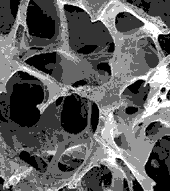Tissue Engineered Bone Grows Strong

Osteofoam™ scaffold <br>Molly Shoichet and John E. Davies Research Laboratories (U. Toronto) BoneTec Corp.
By closely following nature’s blueprint, Toronto researchers have developed an innovative way to speed the healing of severe bone breaks, resulting in what may be the thickest tissue-engineered bone ever produced in the laboratory.
The new bone grows naturally without the addition of chemical growth stimulants, said Whitaker investigator Molly Shoichet, Ph.D., of the University of Toronto. The innovation is in the design of the synthetic scaffold that provides a framework for the growing tissue.
The design mimics the structure of natural bone so faithfully that some experts in the field cannot distinguish between the two when shown micrographs of each side-by-side, Shoichet said. The research was published in the June 15 issue of the Journal of Biomedical Materials Research Part A.
“The structure is very open and porous,” she said. “There are large interconnections between the pores separated by struts, rather than solid walls.”
Into this spongy matrix, the researchers drizzle bone marrow cells, which can differentiate into osteoblasts, the strong, mineral-like cells of mature bone. The marrow cells take up residence in the scaffold and begin growing and multiplying. As they mature, the scaffold itself dissolves.
“You don’t need growth factors to get the cells into the scaffold,” Shoichet said. “The cells almost fall through it and get stuck along the way.”
The scaffold, developed with coinvestigator John Davies of the University of Toronto, is made of poly(lactide-co-glycolide), a polymer used in sutures. The polymer is processed in a unique way to yield the open, sponge-like structure with pores more than 10 times larger than those that result from conventional processing.
Animal studies show that the scaffold provides an intricate framework for dense new bone growth while it slowly dissolves. In rabbits, strong new bone completely replaced the scaffold in about eight weeks.
For some time, tissue engineers have experimented with scaffolds that promote bone growth. Much of this work has relied on supplementing the cell culture with growth hormones or other stimulating chemicals. Shoichet demonstrates a simpler, more natural way to grow new bone.
“To the best of our knowledge, bone growth throughout such a volume has not been reported before in the literature,” she said.
The University of Toronto has licensed the technology to BoneTec Corp. for commercial development under the trademark name of Osteofoam. Shoichet is a vice president of the company.
The Whitaker Foundation has supported Shoichet’s laboratory through a 1998 Biomedical Engineering Research Grant for research to encourage the regrowth of damaged nerve cells.
Contact:
Molly Shoichet molly@ecf.utoronto.ca, University of Toronto
Frank Blanchard frank@whitaker.org, The Whitaker Foundation
Media Contact
More Information:
http://www.whitaker.org/news/shoichet.htmlAll latest news from the category: Health and Medicine
This subject area encompasses research and studies in the field of human medicine.
Among the wide-ranging list of topics covered here are anesthesiology, anatomy, surgery, human genetics, hygiene and environmental medicine, internal medicine, neurology, pharmacology, physiology, urology and dental medicine.
Newest articles

Trotting robots reveal emergence of animal gait transitions
A four-legged robot trained with machine learning by EPFL researchers has learned to avoid falls by spontaneously switching between walking, trotting, and pronking – a milestone for roboticists as well…

Innovation promises to prevent power pole-top fires
Engineers in Australia have found a new way to make power-pole insulators resistant to fire and electrical sparking, promising to prevent dangerous pole-top fires and reduce blackouts. Pole-top fires pose…

Possible alternative to antibiotics produced by bacteria
Antibacterial substance from staphylococci discovered with new mechanism of action against natural competitors. Many bacteria produce substances to gain an advantage over competitors in their highly competitive natural environment. Researchers…





















